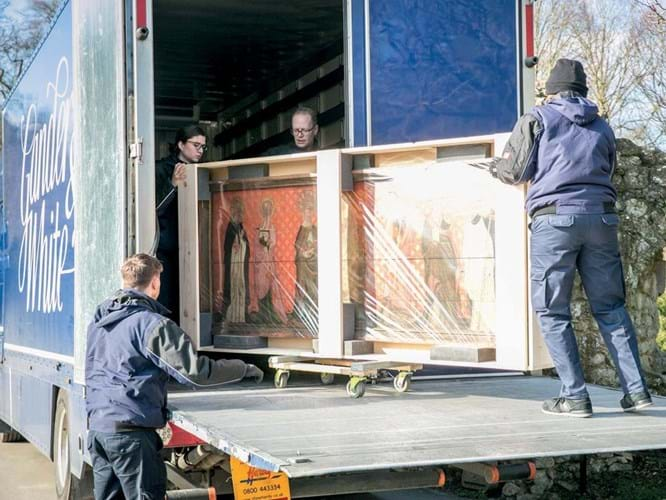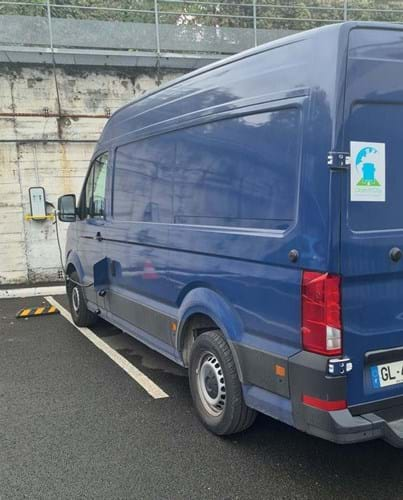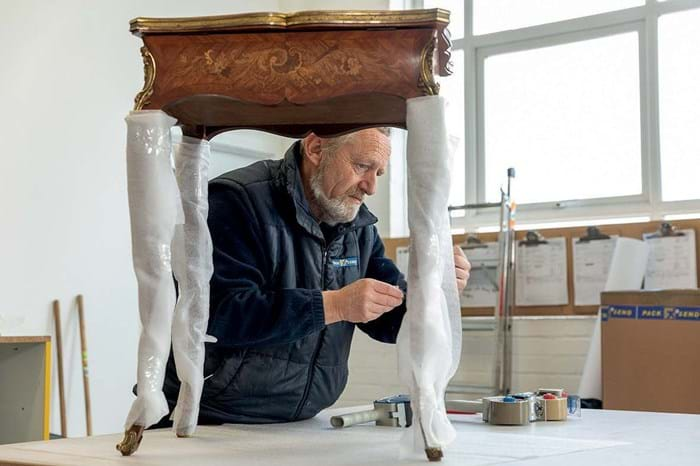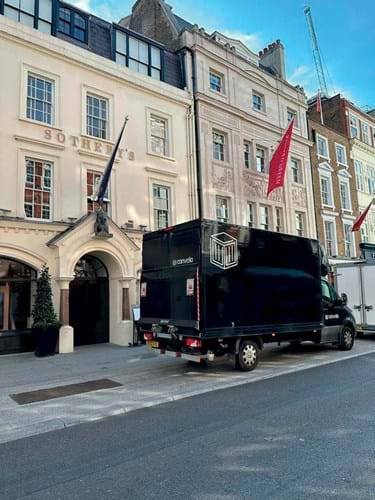As the eager delegates packed into the main hall of the Church House Conference Centre in Westminster for the latest Art Business Conference, sea freight and packing materials might seem unusual topics to bring in the crowds.
But it was one of the hot topics in focus at the 9th edition of the conference earlier this month. Speakers used the event to update art and antiques specialists on sustainable art market initiatives.
Julien Pradels, global head of operations at Christie’s, said: “We see momentum. We are on track to reduce our carbon emissions by 50% (set in 2019).”
In April 2022, Christie’s and logistics firm Crozier teamed up and launched a regular service of moving art works by sea rather than air (as reported in ATG No 2539).

The panel at the Art Business Conference titled ‘Sustainability and the artworld - where are we now?’ was moderated by journalist Louisa Buck with Julien Pradels of Christie’s, Tu Le at Accenture, Graham Bence at Crozier and art dealer Kate MacGarry.
Image: Art Business Conference and David Owens.
Pradels added: “By communicating we have learned a lot… Such as sharing containers and reusing crates.”
Graham Bence of logistics firm Crozier said: “We are so pleased that it is established and successful. The figures show it has a great take-up from Christie’s and others. Interest has been stirred in the gallery world. To create this culture we need to collaborate.”
Sea freight provides an 80% reduction in carbon emissions compared with air freight.
Panellist Kate MacGarry of MacGarry Gallery said: “It was easy to convince artists about sea freight.
But the issue was the collectors. They can ship how they like. However, it was a real help to tell them that Christie’s was doing sea freight. That encouraged some. We would like it if more shipping firms offered sea freight like Crozier.”
There are still the other elements of logistics to consider, though, such as packaging and travel either side of the ports.
Bence added: “We also worked on schedules to make sure our trucks are not running half full, for example, and ensure that packaging is reusable or recyclable.”
It isn’t just to impress conference audiences; the world of logistics has plenty of initiatives to shout about which are designed to boost its green credentials.
Growing awareness
Speaking to ATG for this report, Edouard Gouin, CEO and co-founder of Convelio, says: “Environmental sustainability has gained prominence, leading more companies to adopt carbon-reporting practices. This trend reflects a growing awareness of the environmental impact of business operations.”
The Gallery Climate Coalition (GCC), a not-for-profit group of galleries, auction houses and advisers, has grown its membership and has many initiatives to keep sustainability on the agenda.
As part of its Sustainable Shipping Campaign, it has introduced a system to indicate which shipping services are most conducive to the coalition’s 2030 target. GCC said 70% of its gallery members would favour shippers with more sustainable services.
It has also introduced two tiers of members. Its advanced ‘Active Members’ group must complete a GCC CO2online report or audit within the last two years, establish and maintain a ‘Green Team’ and publish an environmental responsibility statement. Overall, GCC has more than 950 members who have all agreed to its target of a 50% reduction of carbon dioxide emissions by 2030, in line with the Paris Agreement, and it currently has 81 ‘Active Members’.
Jonathan Schwartz, chairman of ICEFAT (International Convention of Exhibition and Fine Art Transporters), says changes are also starting to happen in the museum world, where people are questioning “the preconceptions regarding the appropriate environment for the storage of artworks” which will eventually “have an impact on energy use and can significantly reduce the carbon footprint of warehouses, galleries and museums”.
But a lot still needs to be done. Lapo Serge of ICEFAT member company Apice in Italy, reminds us that the “standard policies for exhibitions are mainly anti-green: dedicated transports, follow cars, dedicated pallets and air travel for couriers which are all requirements with a heavy impact on the carbon footprint of the whole movement.”
Christophe Piette of France’s Andre Chenue says things will change and a “circular economy for raw materials and upcycling will eventually be the norm”.
But there is a balance between being green and the costs to the client. Chenue’s trucks now use biodiesel leading to 80-90% CO2reduction which has increased the price by 3% for its customers. It operates on an opt-out model where, if the customer asks for traditional fuel, it will decrease its price by 3%.
Graeme Rhodes, head of marketing at Pack & Send UK, says the firm undertook research that found “businesses were prepared to accept price increases of less than 5% for carbon-neutral/carbon-offset shipping services - and that was before the effects of inflation started to hit.”
James Simmons, head of group marketing at Mail Boxes Etc., concurs: “There is limited enthusiasm to pay more for packaging using green techniques and materials, and for high-value and fragile items that require purpose built crates or cartons.
“However, where possible MBE always assesses the best packaging solution for each shipment and use eco-friendly packaging options where appropriate.”
Auction houses have the same issue as the shippers themselves. Customers are not always keen to foot the cost to be green.
Gloucestershire saleroom Harper Field’s Lyn Bowkett says: “One recently available product is paper bubble wrap, but to be frank the cost of this is a real issue. We constantly tread a fine line when packing items for transport - their safety in transit is paramount, so plenty of top-quality packing materials are essential, but it is very important to our buyers that we keep the cost to a minimum.
“We do our utmost to pack items exceptionally well while still offering postage at reasonable cost, so it isn’t always possible to upgrade to the latest product if the cost is beyond what our buyers can reasonably afford.”
Moving with the times
But there is no doubt that the requirement to move art and antiques will continue to grow; whether it is international touring museum shows to the growth in buying online, art and antiques logistics is a growth industry.
Even after a natural decrease in the growth of online art buying last year, following the lifting of Covid restrictions, many shippers believe the online art and antiques buying trend will continue.
Edouard Gouin, CEO and co-founder of Convelio, says: “There has been a definite increase in online transactions. The past year has witnessed a significant upswing in online transactions across the market. This surge is attributed to the ongoing digital transformation and the influence of the global pandemic.
“Consumers are increasingly turning to online platforms for their shopping and service needs, underscoring the importance of robust online infrastructure, secure payment gateways, and seamless user experiences.”
Convelio has recently expanded to cater for some of this growth. Earlier this year it bought UK fine art shipper Connoisseur International Fine Art (CIFA).
Previously, Convelio, which operates an online service for the booking of logistics, worked with vetted partners.
Now the group has launched two tiers: ‘Convelio Essential’, a cost-efficient shipping service for furniture, paintings and antiques, alongside ‘Convelio Fine Art’, for the transportation of high-value or fragile art, sculpture, masterpieces and rare antiques.
Duncan Hypher, business development, compliance marketing and lead generation at Mail Boxes Etc., adds: “Over the past year, we have observed a significant increase in online buying activity within the auction industry.
“While the cost of living increases have dented the customer wallet, more people are participating in online auctions, leading to a greater demand for reliable and efficient delivery services. Customer enquiries for collection, packing and shipping of lots won at auction have increased by 26% in 2023 versus the same period in 2022 (Jan-July).”
So shipping is likely to be a hot topic at conferences for the foreseeable future.


















